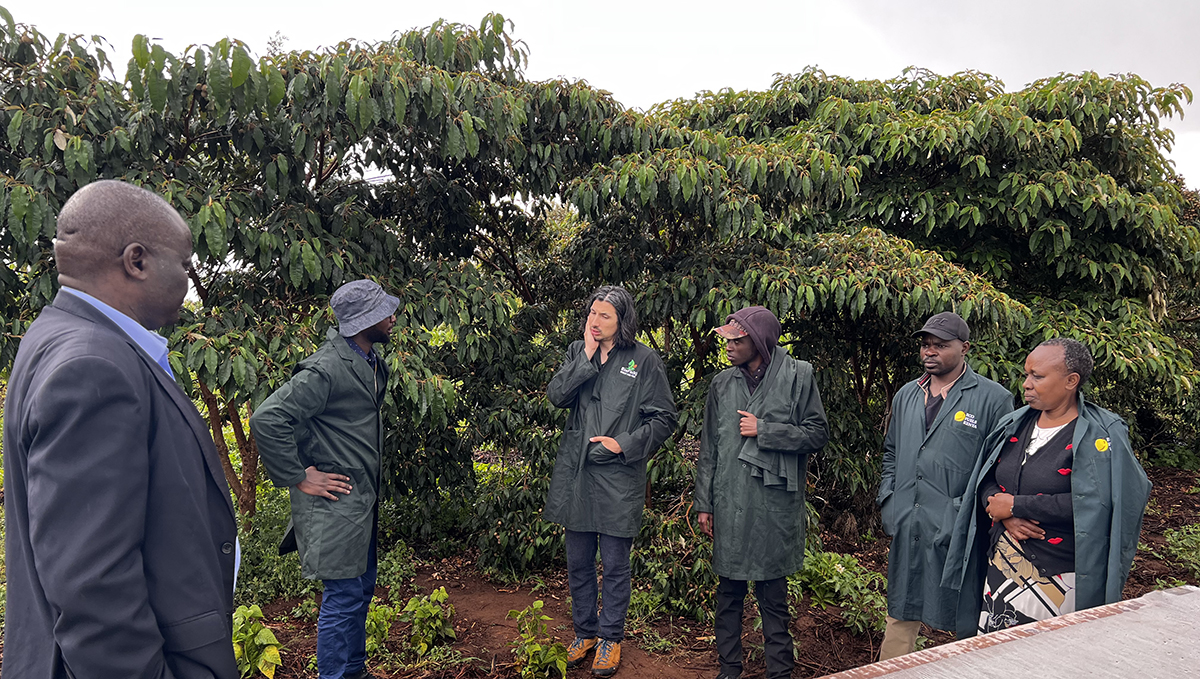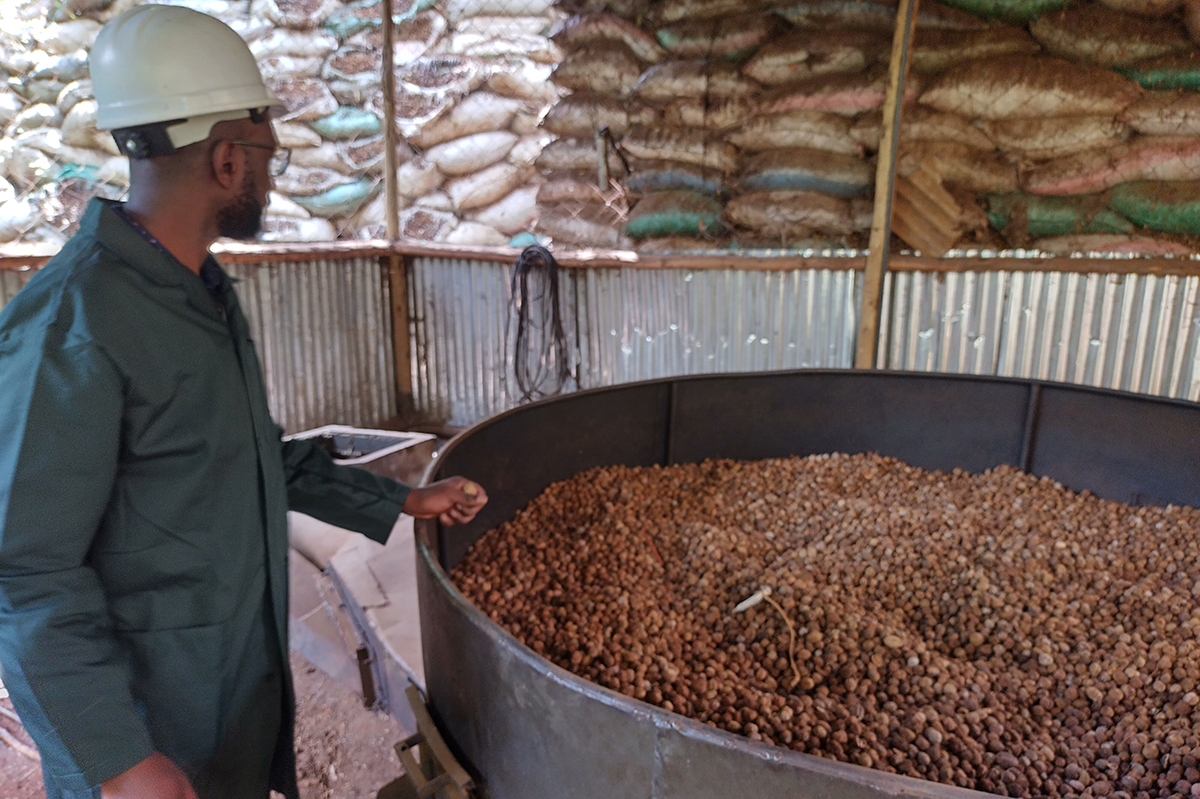Modern agriculture is heavily reliant on pesticides to meet the food, feed and fibre demands of a rising global population. Pesticide use has dramatically increased worldwide; however, increasing concern about their safety and sustainability is driving growing demand for alternatives to synthetic pesticides.
A team from NRI is working with partners in Kenya to expand the repertoire of commercially available natural pest control products or ‘biopesticides’. These are derived from such natural materials as animals, plants, bacteria and certain minerals. The team aims to develop and determine the viability of a sustainable, pyrethrum-based, environmentally benign pest control product incorporating oil from the local croton nut. Croton nuts are sourced from the Croton megalocarpus tree, one of the most prominent indigenous species across ten countries in Sub-Saharan Africa.
‘We hope to develop a fully organic, effective pyrethrum-based product which can be produced from locally available East African natural products,’ said Dr. Mandela Fernández-Grandon, Senior Research Fellow in behavioural entomology and chemical ecology, who leads the NRI team on this project.
 From 26 June to 1 July, Dr. Fernández-Grandon and Prof. Phil Stevenson, an expert in plant chemistry at NRI, were in Kenya to meet project partners, organise upcoming field trials and view the current production process. Representatives from Egerton University, the in-country academic research partner and Ecofix, the main commercial partner on the project met with the NRI team. Ecofix is responsible for producing this pyrethrum-based pesticide. The company also manages the field trials which are based in the central Kenyan area of Nanyuki. Field trials involve application of the new product on a variety of crops to establish its effectiveness. NRI is supporting the project through collaboration on field trials and capacity building through training in laboratory analytical techniques and insect bioassays. Insect bioassays are methods used to establish the relationship between the dose/concentration of an insecticide administered and the level of response in a living organism such as a target pest. These procedures are essential in determining the effectiveness of a pesticide and the appropriate application dose.
From 26 June to 1 July, Dr. Fernández-Grandon and Prof. Phil Stevenson, an expert in plant chemistry at NRI, were in Kenya to meet project partners, organise upcoming field trials and view the current production process. Representatives from Egerton University, the in-country academic research partner and Ecofix, the main commercial partner on the project met with the NRI team. Ecofix is responsible for producing this pyrethrum-based pesticide. The company also manages the field trials which are based in the central Kenyan area of Nanyuki. Field trials involve application of the new product on a variety of crops to establish its effectiveness. NRI is supporting the project through collaboration on field trials and capacity building through training in laboratory analytical techniques and insect bioassays. Insect bioassays are methods used to establish the relationship between the dose/concentration of an insecticide administered and the level of response in a living organism such as a target pest. These procedures are essential in determining the effectiveness of a pesticide and the appropriate application dose.
Pyrethrum is one of the oldest natural insecticides used in the world today, and has one of the best safety records of all insecticides. It is a mixture of various insecticidal chemicals, called pyrethrins, which are extracted from some types of chrysanthemum flowers. However, currently commercialized pyrethrum-based pesticides also rely on incorporating by-products of the petroleum industry to achieve peak effectiveness. These pesticides are therefore associated with a higher carbon footprint and not considered truly organic. For example, toxic solvents like Shell Sol® are used to extract the pyrethrins from flowers and synthetic additives are used as stabilizers, synergists and carriers in the final products. Synergists are chemicals that make pesticide ingredients more effective at killing pests while carriers are the main materials used to enable effective dispersal of a pesticide.
 The new pyrethrum-based product incorporating croton oil has demonstrated its effectiveness against pests in trials and the development team hope to get it to market soon. ‘We have some promising early evidence from our work and are already moving forward with the steps towards verification and registration,’ Fernández-Grandon noted.
The new pyrethrum-based product incorporating croton oil has demonstrated its effectiveness against pests in trials and the development team hope to get it to market soon. ‘We have some promising early evidence from our work and are already moving forward with the steps towards verification and registration,’ Fernández-Grandon noted.
Once delivered, the product will be helpful in reducing the environmental impact of pesticide use, thereby benefitting people in the country as users of the product and producers of the raw materials. The economic benefits will encourage growth in the number of farmer suppliers and processing plants once the sector is revived. Kenya was formerly the global leader in pyrethrum production contributing 90% of global supply in 1983 with nearly 30,000MT. This indicates the potential for this technology and scope for income generation among smallholders.
Biopesticides are typically specific in their action and have low persistence which reduces pollution concerns. They are considered more environmentally benign, and easier to source compared to synthetic pest control products. This explains their rising prominence as alternatives to synthetic pesticides amid growing concern for human and environmental health as well as sustainable agricultural production systems. New organic formulations and processing techniques developed during the project will provide new products that will motivate more customers and help support the continued growth of the pyrethrum industry and, more importantly, sustainable food production.

